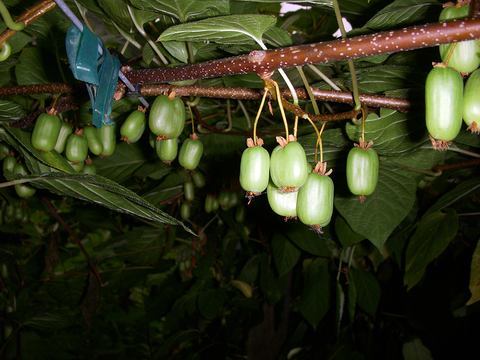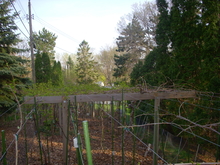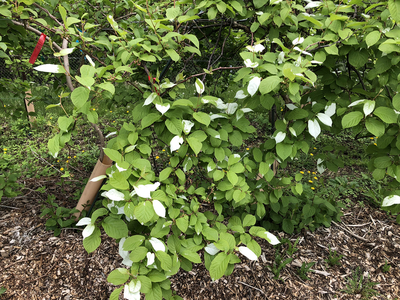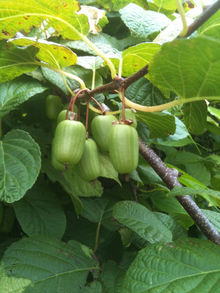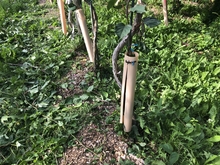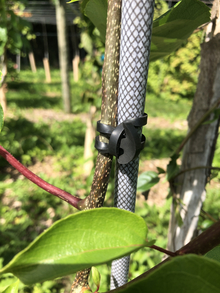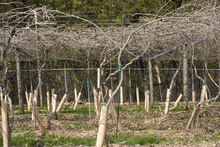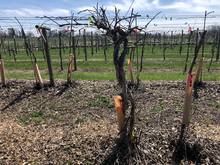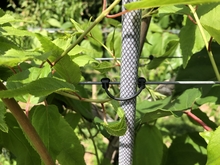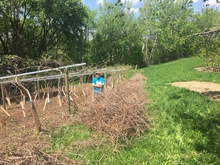Keep up with the latest kiwiberry research on the University of Minnesota Fruit Research site and follow @umnfruit on Instagram.
Quick facts
-
Kiwiberry vines require moist, well-drained soil.
-
A vine will produce either male or female flowers. Plant one of each gender to get fruit.
-
One male vine provides enough pollen for up to 6 female vines.
-
Vines need to be pruned every winter and sheared during the growing season to keep them under control.
-
Expect to get fruit 3 to 5 years after planting.
-
The vines climb and should be planted near a sturdy support structure.
There are about 80 species of kiwi (in the genus Actinidia), which are native to the forests of eastern Asia. Species that can be grown in Minnesota are called "kiwiberry" because they produce grape-sized berries with a flavor similar to fuzzy kiwifruit, though a bit sweeter. Unlike the larger fuzzy kiwi, kiwiberries have thin, smooth skin and do not need to be peeled before eating.
Two species, Actinidia kolomikta and Actinidia arguta, can be grown for fruit in Minnesota and similar regions. A third species, Actinidia polygama, has an unusual spicy, green-pepper flavor that some people find too strong, so it is usually grown as an ornamental vine.
Kiwiberry vines have attractive foliage. In fact, for many years, fruitless varieties of these plants were grown in the U.S. strictly for ornamental use. The vigorous growth habit makes the vine perfect for growing on trellises, arbors, patio overheads, fences or walls. It’s only in the last few decades that people have begun to value the fruit.
Meet the Kiwiberry
Many aspects of kiwiberry production in Minnesota are still in the research phase. The region-specific growing recommendations on this page are based on our research to date. We will continue to update information as we discover more.
Selecting kiwiberry plants
Most kiwifruit plants are either male or female: the males supply the pollen and the females produce the berries. To get fruit you need to plant one of each. On a larger scale, you would plant one male vine for each 6 to 8 female vines.
Several named varieties of each species are available. New varieties will likely be available soon thanks to fruit breeding programs across the U.S.
Characteristics of kiwiberry species for Minnesota
| A. kolomikta | A. arguta | A. polygama | |
|---|---|---|---|
| Common name | Arctic Beauty | Bower Berry | Silver Vine |
| Hardiness zone | Zone 3 | Zone 4 | Zone 4 |
| Fruit flavor | Very good with a unique sweet-tart flavor and high-sugar content. | Excellent sweet-tart flavor, to over-fruity, to bland. Depends on variety. | Unripe fruit has green pepper to spicy flavor. Ripe fruit is bland and unpleasant. |
| Harvest date | Mid-August to mid-September. Some as early as July or as late as October. | Late August to mid-October | Mid- to Late September |
| Berry size | Small (2 to 8 grams) | Wide range (5 to 20 grams) | Small (3 to 10 grams) |
| Fruit yield | Up to 15 pounds | Up to 40+ pounds | Up to 15 pounds |
| Plant spacing | 10 to 20 feet apart | 20 to 30 feet apart | 10 to 20 feet apart |
| Varieties |
|
|
|
| Characteristics |
|
|
|
| Challenges |
|
|
|
Leaves, flowers and berries of the different kiwiberry species
Care through the seasons
| Things to do | When to do them |
|---|---|
| Plant kiwiberry vines in spring after the threat of frost is past. | May |
| Control weeds throughout the growing season. | May through September |
| Tie new growth to trellis as needed. | May through August |
| Prune excessive non-fruiting “explorer” shoots. | June to early July |
| Harvest mature berries. Timing depends on variety. | July through October |
| Clean up any fallen fruit to prevent Spotted Wing Drosophila. | August through October |
| Prune dormant vines in late fall after soil freezes and before significant snowfall. | November |
Planting and caring for plants
Several Minnesota retail nurseries sell kiwiberry vines. Plants can also be ordered from many nurseries online, and are usually shipped dormant and bare-root. Remember to buy a male vine and a female vine.
In the wild, the trunks of kiwifruit vines grow on the edges of forests where they are partially shaded by trees. The trees also provide protection from strong winds and help protect tender shoots during the spring growth. The cooler soil and air temperatures of these locations delay flowering in the spring and help retain soil moisture during the growing season — both good things.
Plant vines in a location where they will be shaded from afternoon sun and winter sun, such as north or east of a treeline or building structure. These locations contribute to cooler and moister soil conditions that kiwifruit like. This is especially important for A. kolomikta; A. arguta can tolerate more sun.
- The planting location should allow for air circulation and avoid low-lying areas that can become frost pockets.
- Plant bare-root or container-grown plants early in the spring after the risk of frost is past.
- Mulch the base of each vine with wood chips.
- Kiwifruit vines grow best in a well-drained, aerated and moisture-holding soil that is slightly acidic to neutral (pH 5.5-7.5), and rich in organic matter.
Mulch
Use a 4-inch thick layer of mulch to retain moisture, regulate soil temperatures, control weeds and encourage healthy root growth.
Compared with plants grown in bare soil, A. kolomikta grown under a thick layer of mulch tend to have a more extensive and denser root system with dense fine roots. Roots can extend several feet out from the trunk where the mulch meets the soil.
In the spring, the cooler soil temperatures beneath the mulch layer can delay buds opening until temperatures are warm enough. Mulch also can reduce injuries from spring freezing.
Recommended mulch materials:
Wood chips
Leaf mulch
Corn stover
Fertilizer
Once the vine has begun fruiting, annual fertilizer may be necessary. Apply compost or a light application of a balanced fertilizer around the trunk area in the spring after risk of frost is past. To prevent excessive late season growth, do not fertilize after July.
For soils with low organic matter, additional nitrogen might be needed. Although, too much nitrogen causes excessive vegetative growth, so be careful not to over-fertilize. Have your soil tested every couple of years to guide your fertilizer strategy.
Watering
Watering is likely to be required during most Minnesota summers, especially those that are dry in mid- to late season. Drought-stressed plants are prone to smaller fruit, premature berry drop, and are more susceptible to winter cold injury.
Weeding
Keep weeds and grass away from around the base of kiwifruit vines to prevent competition for water and nutrients. A 4-inch layer of wood chip mulch will help control weeds.
Insect damage is rare on kiwifruit vines, though spotted wing drosophila, a fruit fly, may appear where overripe fruit is left on the vine or on the ground. Pick all the fruit at harvest time and remove any fruit that falls to the ground.
Rabbits and deer can cause problems to the trunk and foliage. Rabbits chew on the bark in fall and winter and may completely girdle the vine's trunk. Surround the trunks with fencing or plastic trunk guards higher than the expected snow depth to protect from rabbit damage.
Deer may browse kiwiberry leaves throughout the growing season until the vines reach a height where the deer can no longer reach the foliage.
Diseases and challenges
Aside from the root rots common to kiwifruit in poorly drained soil, there are no significant diseases to worry about when growing kiwiberry.
- Prevent root rot by planting vines in well-drained soil.
- Do not over-water.
- Do not plant near black walnuts or hickories as juglones in the soil derived from those trees will kill the vines.
- The berries begin to ripen in late July, and harvest may extend into late October.
- Cool night temperatures encourage ripening.
- Immature berries are glossy, opaque and hard.
- As they ripen, the berries become dull, translucent and soft when gently squeezed.
- Berries of A. kolomikta varieties may also develop yellowish vertical stripes.
- Once the berries start to ripen, it is time to pick all of them.
Storage
Like fuzzy kiwifruit, they are best eaten fresh and can be refrigerated for a week or two. To extend storage life, separate the firm berries from the soft ones and remove all debris and damaged fruit. Place the firm berries in special plastic fruit storage bags designed to absorb fruit-ripening ethylene gas. These can be found in many grocery stores and online.
Sunscald
In late winter, the warmth of the sun combined with the reflection off the snow surface heats up the wood tissue in the vine's trunk. After sunset, the temperature cools quickly and refreezes this tissue. That rapid thaw-freeze cycle can result in death of cambium-layer tissue under the bark and lead to cracking of the trunk, severely damaging the vine. This is called sunscald injury.
-
All young vines are susceptible to sunscald because of their thin bark.
-
A. kolomikta vines of all ages are susceptible because of their dark-colored bark that readily absorbs heat.
-
Mature vines of A. arguta develop a thick, shaggy bark. Once mature, these vines are not as prone to sunscald and do not need as much protection from winter sun.
Ways to protect vines from sunscald:
-
Place a shade barrier on the south and southwest sides of the vine's trunk to protect from sunscald if not enough shade is available.
-
Use plastic spiral wraps, split grow-tubes, or full grow tubes or tree shelters around the trunk.
-
If using split grow-tubes, the split side should be placed on the north side of the trunk and secured at the top to keep them from blowing off in strong winds.
-
Spiral and full grow tubes and tree shelters can also prevent rabbit damage in winter. Split tubes do not protect the vines from rabbit damage, since the animals can access the trunk from the open side.
Training and pruning
Kiwiberry vines need sturdy support for growth. The vine twists counterclockwise around support structures and become heavy by mid-season.
- On the scale of a home garden, a T-bar trellis system is a good choice.
- Decorative structures can work too.
- Sturdy pergolas or arbors offer good structure for the vines to climb on and would make the fruit easily accessible for picking.
- A fence could work also.
- As you choose your structure, remember that you’ll need to be able to reach all parts of the vine for training, pruning and harvesting.
New vines take 4 to 5 years to train for production. Vines with an established root system that need to be re-grown and trained (because of winter injury) may take one to three years to train.
These guidelines are intended for vines being trained on a T-bar trellis. If you are using a decorative structure for supporting your vines, you’ll have to make some adjustments to the methods. Do your best to follow them as closely as possible to grow vines that are easy to manage and that produce a lot of fruit.
First growing season
- Transplant bare-root or container-grown vines early in the spring after risk of frost is past.
- This will allow the root system to become well-established before winter and promote growth the following year.
- Most vegetative growth occurs early in late spring to early summer.
- Rapid growth ends sooner for A. kolomikta compared to A. arguta.
Second growing season
- In the spring, look for a thick and vigorous shoot that is about the thickness of a pencil emerging near the base of the trunk.
- In late June, once this shoot starts to become woody, prune away all other growth to leave this as the single shoot. This will become the vine’s main trunk.
- Loosely secure the shoot about one foot below the growing tip to a support stake and allow it to grow for the remainder of the season, or until it reaches the trellis wire or support structure above.
- Then pinch back the growing tip to encourage the development of a secondary side shoot.
- This second shoot should be located about two thirds of the way up the trunk to the trellis wire to form a "Y" configuration at the split.
- These will become the two main branches or cordons.
Third growing season
- Cross the two cordons past one another so one cordon arm of the "Y" goes from the 2:00 position to 10:00, while the other cordon arm of the "Y" goes from 10:00 to 2:00.
- If you're growing vines on a decorative structure, you might have to make some adjustments to this method.
- As growth progresses, loosely tie the two cordons to the trellis wire.
- Allow secondary shoots to emerge and grow out from the two cordons at uniformly spaced intervals of 8 to 12 inches.
- Snip off any side shoots that appear lower down on the trunk.
- Remove any vigorous "explorer shoots" that may emerge from the cordons since these will not produce flowers or fruit, and will crowd the canopy.
Fourth growing season
- Tie down the secondary canes to the support wires.
- Specialized plastic vine buckle clips keep the shoots in place and will keep them from shifting.
- Flower-bearing shoots are recognized by their closely-spaced buds.
- These shoots will carry the fruit crop (for female vines) and pollenizer flowers (for male vines) in the following year.
Fifth season and beyond
Prune out old secondary canes and tie down new secondary canes that formed during the preceding growing season.
Much of the vegetative growth occurs during the spring and early summer. Left unchecked, vines can grow into a tangled mess within a few seasons. In Minnesota there are three seasons when pruning is done, and each season's pruning is a little different.
Mid- to late autumn
Major pruning should be done at this time of year, once the soil begins to freeze but before significant snowfall. This will prevent heavy snow loads from building up on the vines and potentially damaging support structures.
At this time, cuts on exposed wood will have the opportunity to dry out over the winter and reduce the potential for sap flow, or "bleeding" in the spring.
- After the vines go dormant in fall or early winter, retain new shoots with close bud spacings, as these are likely to produce flowers the following spring.
- Remove canes that fruited during the previous season along with dead, diseased or tangled canes.
- Keep the best one-year-old lateral canes that haven't fruited, spaced about a foot apart along the arms.
Late winter
- It is ideal to do dormant pruning in late fall before heavy snowfall. However, if pruning isn't completed in late fall, it can also be done in late winter.
- Prune while the soil is still frozen.
- Pruning cuts made at this time of year will be subject to profuse sap-flow "bleeding". Prevent this by painting the cut areas with latex paint on a day when air temperatures are expected to remain above freezing for several hours so the paint can dry.
Spring and early summer
- Pruning at this time of year consists mostly of shearing, shaping, thinning and training.
- Two or three times during the summer, cut non-flowering laterals back.
- Trim flowering shoots back to four to six leaves beyond the last flower.
Follow kiwiberry research
For general production information, take a look at resources developed by Oregon State University and the New Hampshire Agricultural Experiment Station.
Funding for this publication was provided by the Minnesota Department of Agriculture (MDA) and made possible by the U.S. Department of Agriculture's (USDA) Agricultural Marketing Service through grant No. AMI170100XXXXG008. Its contents are solely the responsibility of the authors and do not necessarily represent the official views of the USDA or MDA.
Reviewed in 2024


